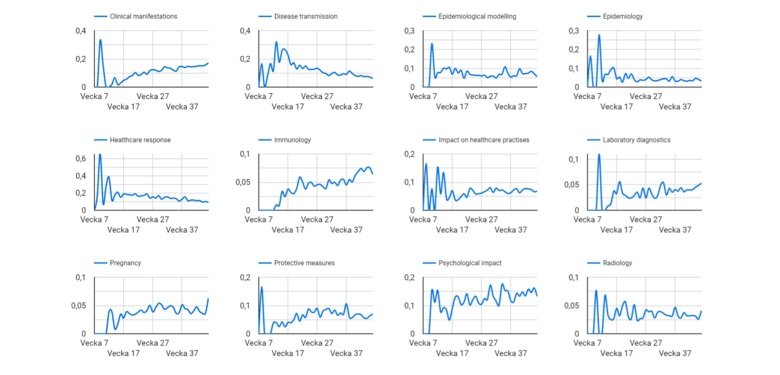Survey of COVID-19 research provides fresh overview

Researchers at Karolinska Institutet have explored all COVID-19 research published during the initial phase of the pandemic. The results, which were achieved by using a machine learning-based approach and published in the Journal of Medical Internet Research, will make it easier to direct future research to where it is most needed.

In the wake of the rapid spread of COVID-19, research on the disease has escalated dramatically. Over 60,000 COVID-19-related articles have been indexed to date in the medical database PubMed. This body of research is too large to be assessed by traditional methods, such as systematic and scoping reviews, which makes it difficult to gain a comprehensive overview of the science.
“Despite COVID-19 being a novel disease, several systematic reviews have already been published,” says Andreas Älgå, medical doctor and researcher at the Department of Clinical Science and Education, Södersjukhuset at Karolinska Institutet. “However, such reviews are extremely time- and resource-consuming, generally lag far behind the latest published evidence, and only focus on a specific aspect of the pandemic.”
Machine learning technique
To obtain a fuller overview, Andreas Älgå and his colleagues have employed a machine learning technique that enables them to map key areas of a research field and track the development over time. This present study included 16,670 scientific papers on COVID-19 published from 14 February to 1 June 2020, divided into 14 different topics.
The study shows that the most common research topics were health care response, clinical manifestations, and psychosocial impact. Some topics, like health care response, declined over time, while others, such as clinical manifestations and protective measures, showed a growing trend of publications.
Protective measures, immunology, and clinical manifestations were the research topics published in journals with the highest average scientific ranking. The countries that accounted for the majority of publications (the USA, China, Italy and the UK) were also amongst the ones hardest hit by the pandemic.
Developed a website

“Our results indicate how the scientific community has reacted to the current pandemic, what issues were prioritised during the early phase and where in the world the research was conducted,” says fellow-researcher Martin Nordberg, medical doctor and researcher at the Department of Clinical Science and Education, Södersjukhuset (KI SÖS).
The researchers have also developed a website, where regular updates on the evolution of the COVID-19 evidence base can be found (www.c19research.org).
“We hope that our results, including the website, could help researchers and policy makers to form a structured view of the research on COVID-19 and direct future research efforts accordingly,” says Dr Älgå.
Publication
“Analysis of Scientific Publications During the Early Phase of the COVID-19 Pandemic: Topic Modeling Study”. Andreas Älgå, Oskar Eriksson, Martin Nordberg. Journal of Medical Internet Research, 10 November 2020, doi: 10.2196/21559.
